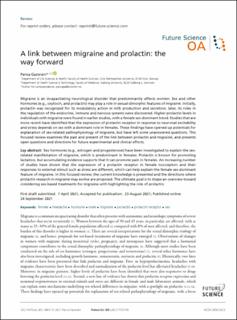| dc.description.abstract | Migraine is an incapacitating neurological disorder that predominantly affects women. Sex and other hormones (e.g., oxytocin, and prolactin) may play a role in sexual dimorphic features of migraine. Initially, prolactin was recognized for its modulatory action in milk production and secretion; later, its roles in the regulation of the endocrine, immune and nervous systems were discovered. Higher prolactin levels in individuals with migraine were found in earlier studies, with a female sex-dominant trend. Studies that are more recent have identified that the expression of prolactin receptor in response to neuronal excitability and stress depends on sex with a dominant role in females. These findings have opened up potentials for explanation of sex-related pathophysiology of migraine, but have left some unanswered questions. This focused review examines the past and present of the link between prolactin and migraine, and presents open questions and directions for future experimental and clinical efforts. Sex hormones (e.g., estrogen and progesterone) have been investigated to explain the sex-related manifestation of migraine, which is predominant in females. Prolactin is known for promoting lactation, but accumulating evidence supports that it can promote pain in females. An increasing number of studies have shown that the expression of a prolactin receptor in female nociceptors and their responses to external stimuli such as stress are different, which can help explain the female sex-dominant feature of migraine. In this focused review, the current knowledge is presented and the directions where prolactin research in migraine may evolve are proposed. The ultimate goal is to shape an overview toward considering sex-based treatments for migraine with highlighting the role of prolactin. | en_US |

